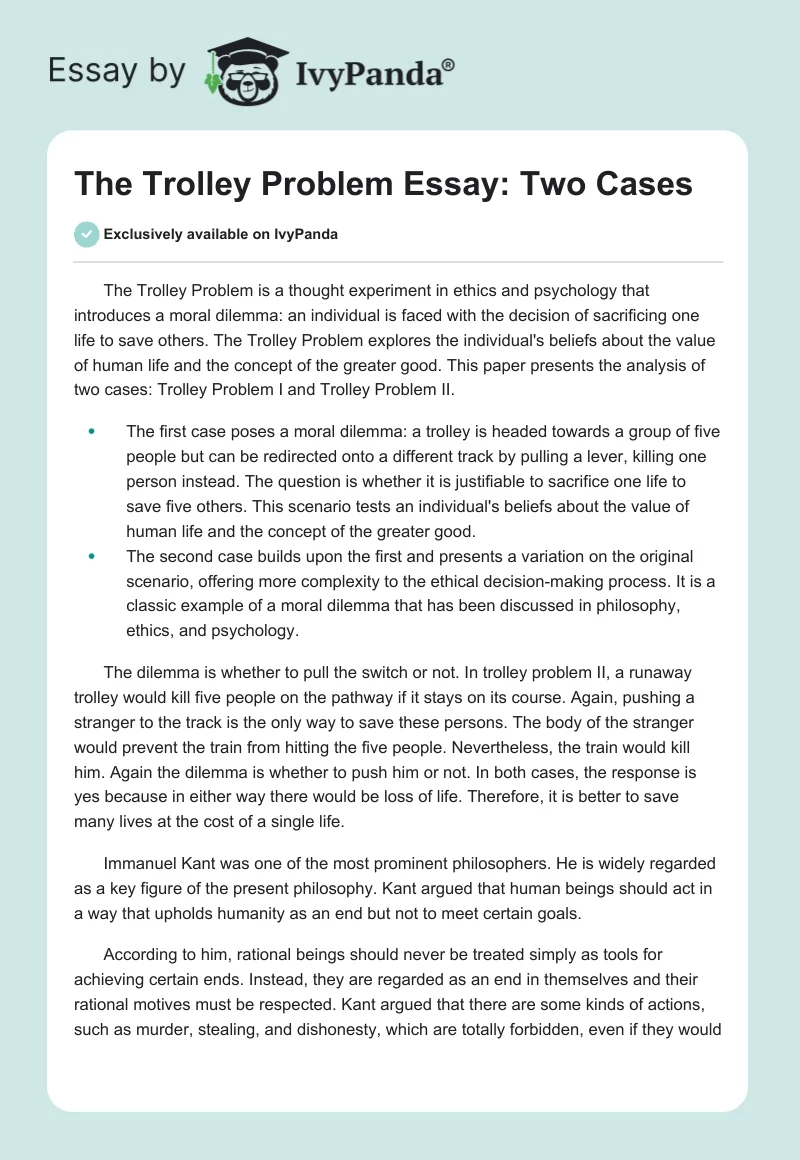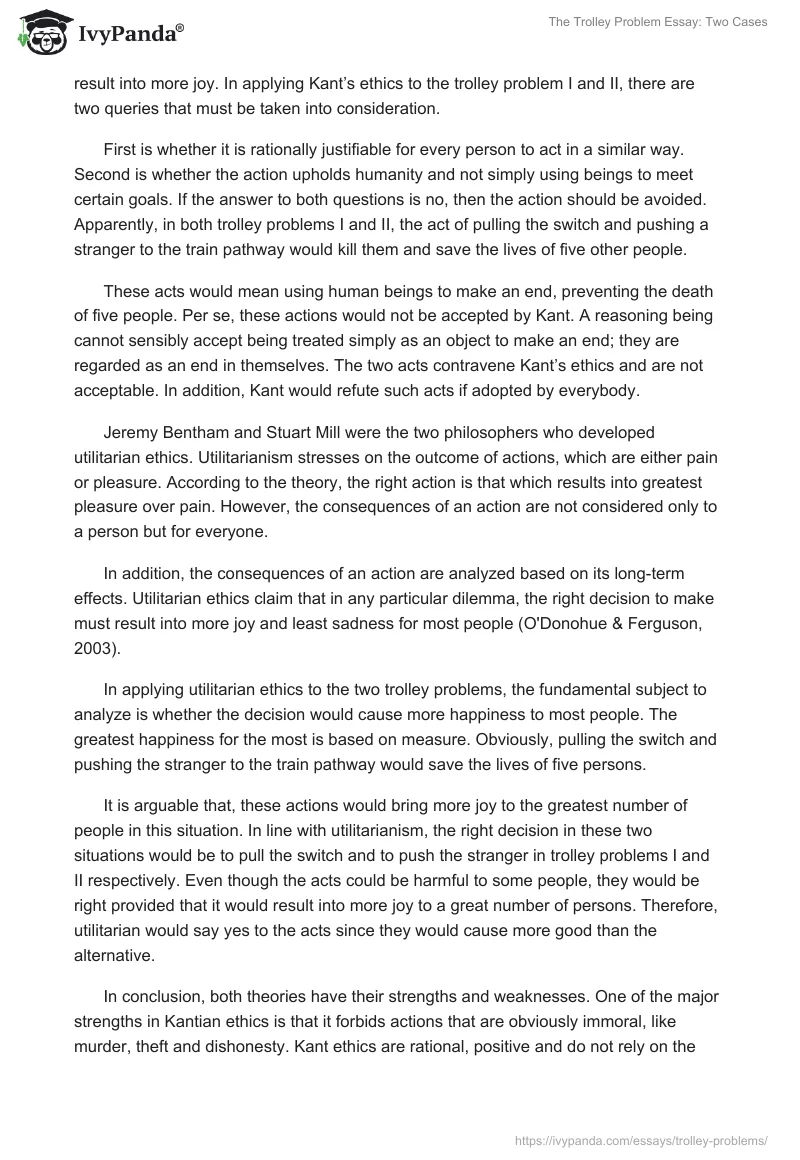This trolley problem essay is about the ethical intricacies of moral philosophy. Delving deeper into the realm of moral decision-making, we have scrutinized the issue. You can learn about the understanding of ethical considerations and the profound implications that shape discourse. This will help you write your own great “The Trolley Problem Answer Essay.”
The Trolley Problem is a thought experiment in ethics and psychology that introduces a moral dilemma: an individual is faced with sacrificing one life to save others. The Trolley Problem explores the individual’s beliefs about the value of human life and the concept of the greater good. In this trolley problem essay, two cases will be analyzed: Trolley Problem I and Trolley Problem II.
- The first case poses a moral dilemma: a trolley is headed towards a group of five people but can be redirected onto a different track by pulling a lever, killing one person instead. The question is whether it is justifiable to sacrifice one life to save five others. This scenario tests an individual’s beliefs about the value of human life and the concept of the greater good.
- The second case builds upon the first and presents a variation on the original scenario, offering more complexity to the ethical decision-making process. It is a classic example of a moral dilemma that has been discussed in philosophy, ethics, and psychology.
In the trolley problem answer essay, the dilemma is whether to pull the switch or not. In Trolley Problem II, a runaway trolley would kill five people on the pathway if it stayed on its course. Again, pushing a stranger to the track is the only way to save these persons. The body of the stranger would prevent the train from hitting the five people. Nevertheless, the train would kill him. Again, the dilemma is whether to push him or not. In both cases, the response is yes because there would be a loss of life either way. Therefore, saving many lives at the cost of a single life is better.
Immanuel Kant was one of the most prominent philosophers. He is widely regarded as a key figure of the present philosophy. Kant argued that humans should act in a way that upholds humanity as an end but not to meet certain goals. According to him, rational beings should never be treated simply as tools for achieving certain ends. Instead, they are regarded as an end, and their rational motives must be respected. Kant argued that there are some kinds of actions, such as murder, stealing, and dishonesty, which are forbidden, even if they would result in more joy. Two queries must be considered when applying Kant’s ethics to the Trolley Problem I and II.
First is whether it is rationally justifiable for every person to act similarly. The second is whether the action upholds humanity and does not simply use beings to meet certain goals. If the answer to both questions is no, then the action should be avoided. Apparently, in both trolley problems I and II, the act of pulling the switch and pushing a stranger to the train pathway would kill them and save the lives of five other people.
These acts would mean using human beings to make an end, preventing the death of five people. Per se, these actions would not be accepted by Kant. A reasoning being cannot sensibly accept being treated simply as an object to make an end; they are regarded as an end in themselves. The two acts contravene Kant’s ethics and are not acceptable. In addition, Kant would refute such acts if adopted by everybody.
Jeremy Bentham and Stuart Mill were the two philosophers who developed utilitarian ethics. Utilitarianism stresses the outcome of actions, which are either pain or pleasure. According to the theory, the right action is that which results in the greatest pleasure over pain. However, the consequences of an action are not considered only for a person but for everyone.
In addition, the consequences of an action are analyzed based on its long-term effects. Utilitarian ethics claim that in any particular dilemma, the right decision to make must result in more joy and less sadness for most people (Tseng & Wang, 2021). In applying utilitarian ethics to the two trolley problems, the fundamental subject to analyze is whether the decision would cause more happiness to most people. The greatest happiness for the most is based on measure. Obviously, pulling the switch and pushing the stranger to the train pathway would save the lives of five persons.
It is arguable that these actions would bring more joy to the greatest number of people in this situation. In line with utilitarianism, the right decision in these two situations would be to pull the switch and to push the stranger in trolley problems I and II, respectively. Even though the acts could be harmful to some people, they would be right, provided that they would result in more joy for a great number of people. Therefore, utilitarians would say yes to the acts since they would cause more good than the alternative.
In conclusion, the trolley problem essay shows how both theories have their strengths and weaknesses. One of the major strengths of Kantian ethics is that it forbids immoral actions, such as murder, theft, and dishonesty. Kant’s ethics are rational and positive and do not rely on the consequences of actions. However, the major weakness in Kant’s ethics is that it does not exempt a maxim.
This is impractical in certain situations where sacrificing a few people could cause more good. It is necessary in trolley I and II problems. The major strength of utilitarian ethics is that it supports the greatest happiness for most people, which could be necessary in some situations. However, it disregards the minority. This means that the rights of a few persons could be violated to make the greatest happiness for most people. It is also unrealistic since most people would not prefer to act in the interest of others above themselves.
Reference
Tseng, P. E., & Wang, Y. H. (2021). Deontological or utilitarian? An eternal ethical dilemma in outbreak. International Journal of Environmental Research and Public Health, 18(16), 1-13.



